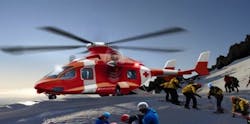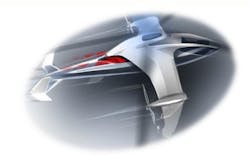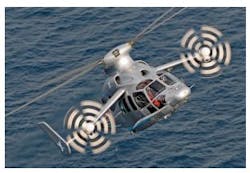Airbus Helicopters to design new compound rotorcraft demonstrator in the frame of Clean Sky 2 program
FARNBOROUGH, England, 17 July 2014. Airbus Helicopters engineers will lead the design of LifeRCraft (Low Impact Fast & Efficient RotorCraft), a large-scale compound rotorcraft demonstrator to be built in the framework of Europe’s Clean Sky 2 Joint Technology Initiative, formally launched last week at Brussels.
The LifeRCraft architecture combines fixed wings for energy-efficient lift, open propellers for high-efficiency propulsion, and a main rotor that provides vertical takeoff and landing (VTOL) flight capabilities.
With today’s formal Clean Sky 2 go-ahead, the Airbus Helicopters-led compound rotorcraft program’s timing calls for preliminary studies, architecture, and specification activity starting this year, with development and testing of component and subsystems envisioned in the 2016-2018 timeframe. Flight evaluations could start in early 2019.
“Clean Sky 2 underscores Europe’s commitment to aligning its strengths and significantly increasing investment in research and technology, building on such advancements as the X3 hybrid demonstrator that successfully validated the compound aircraft configuration and proved its capabilities with a significant breakthrough in terms of rotorcraft speed,” explains Tomasz Krysinski, Airbus Helicopters’ vice president – Research and Innovation. “This will position European industry for the potential development of a commercial aircraft based on this concept, with reduced risk before a go/no-go decision is made.”
Launched in 2008, Clean Sky is a multi-year public-private partnership involving the European Commission and Europe’s aviation industry, with the goal of bringing significant step changes to reducing the sector’s environmental impact. Through a multi-phase approach, Clean Sky 2 is the continuation to the progress achieved in the first Clean Sky Programme which will end in 2017. It intends to speed up technological breakthrough developments and shorten the time-to-market for more competitive and cleaner air transport solutions tested on full scale demonstrators. Through open calls Clean Sky 2 will involve a range of partners throughout Europe, in particular SMEs.
Such a future compound aircraft would combine higher cruise speeds with excellent vertical takeoff and landing performance at affordable operating costs, making it well-suited for such vital public service duties as emergency medical airlift, search and rescue, coast guard and border patrol operations, while contributing to the overall enhancement of mobility through operations ranging from passenger transport and inter-city shuttle services to off-shore airlift for the oil and gas sector, officials say.
Airbus Helicopters is also a player in another demonstrator project, the Green Rotorcraft platform, which calls for the development of a High Compression Engine to drastically reduce the fuel consumption and gas emission of the next generation of light helicopters. Ground tests based on a modified EC120 are planned for the third quarter of 2014.


